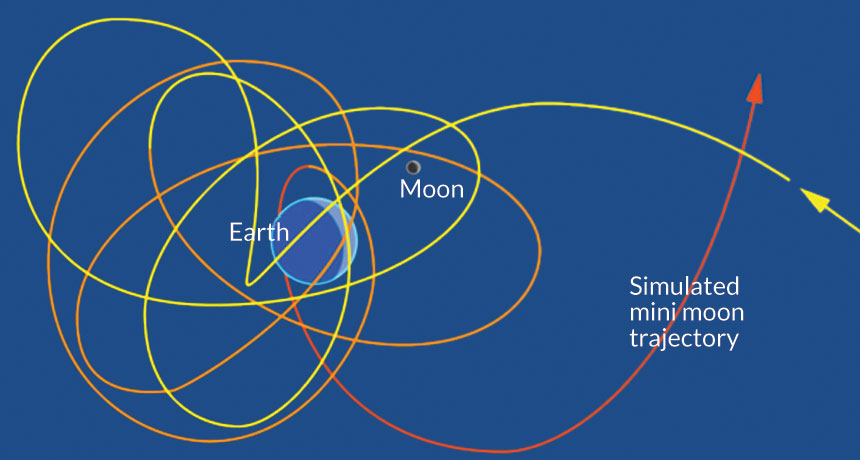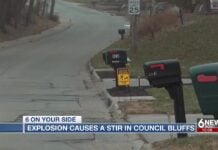Now we’d like to add ‘mini-moons’ to the list of heavenly bodies we should be worried about.
Scientists have claimed our planet was recently hit by one of these mysterious rocks, which exploded in a gigantic fireball.

A mini-moon is an object which becomes entangled in Earth’s orbit as it’s zooming through space.
It will either whirl around the planet harmlessly forever, zoom off back off on its journey through the solar system or, in the worst case, smash into our planet.
‘Objects gravitationally captured by the Earth-Moon system are commonly called temporarily captured orbiters (TCO), natural Earth satellites, or minimoons,‘ scientists wrote in a new study published in The Astromomical Journal.
‘TCOs are a crucially important subpopulation of near-Earth objects (NEOs) to understand because they are the easiest targets for future sample-return, redirection, or asteroid mining missions.
Only one TCO has ever been observed telescopically, 2006 RH 120, and it orbited Earth for about 11 months.‘
However, it’s believed that an ‘extremely slow fireball’ which exploded over South Australia may have been a mini-moon.
It was picked up by six different detectors when it went kaboom in August 2016. No-one was hurt in the incident, but it shows that the movement of objects through the region of space close to Earth is highly unpredictable.
If the rock had been larger, it could have done some major damage.
Dangers of NEOs
It’s very difficult to guess what’s going to happen to an object when it encounters Earth’s gravity because its movements are ‘chaotic in nature and predicting its pre-impact trajectory is very difficult’.
What this means is that if we saw a big asteroid in our planet’s orbit, we wouldn’t necessarily be able to say where and when it was going to hit Earth – or even if it was going to simply zoom around humanity’s homeworld and then travel off into space.
This year, NASA has discovered two asteroids which could be on a collision course with our planet.
Celestial bodies with a chance of smashing into Earth are added into the Sentry database. There are now 25 entries and the list is updated every time a new object that could hit humanity’s homeworld is discovered.
2019 ND7
The first is called 2019 ND7 and was observed in July. This beast is almost 200 metres wide, which is large enough to wipe out an entire city. It could be bigger than a meteor which detonated over Tunguska, Russia, in 1908 and flattened trees over an area of 770 square miles.
2019 WG2
The second asteroid is called 2019 WG2 and was observed this month. It’s much smaller and stretches to just 35 metres wide. However, this could still cause a huge explosion. It’s estimated that a crater outside Winslow, Arizona, was blasted into the Earth 50,000 years ago by a similarly-sized object which exploded with 10 megatons of energy.
There’s a chance of 2019 ND7 crashing into Earth between 2097-2117 on 20 different occasions, while 2019 WG2 could hit between 2098 and 2119 at 56 different times.
Chances of Asteroids Hitting Earth
Luckily, there is only a very small chance of the asteroid hitting Earth. NASA has calculated the risk at 1 in 310,000, meaning there’s a 99.99968% chance the asteroid will miss the Earth.
We also have a grace period, because neither is at risk of colliding into Earth until the end of the century.
Although a meteor the size of the Tunguska can level a city, metropolitan areas take up such a small fraction of the Earth’s surface that a direct impact on one is relatively unlikely.
More likely is an impact in the water near a city that creates a dangerous tsunami.
So, an Earth collision by a sizable near-Earth asteroid is a very low probability event. [Metro]













“Luckily, there is only a very small chance of the asteroid hitting Earth. NASA has calculated the risk at 1 in 310,000, meaning there’s a 99.99968% chance the asteroid will miss the Earth.”
The contention that it is always “very unlikely” that any space rock will hit earth flies in the face of the historical record showing hundreds of space rocks having hit earth in the last 12,000 years, with the most recent just 200 years ago in Saudi Arabia.
The “Whirled Lord” won’t allow or let an asteroid hit Earth pointlessly. They will direct it into a deadly killing monster instead. Can you think of any man-made Frankenstein’s conspicuously not in the news? The formula for averting that outcome is in some grainy circular.
Visualize Whirled Peas.
WAIT TILL 67-P hits earth,11 miles long,4 miles in dia. and traveling at 42.000 mph,and its going to hit down by PUERTO RICO..the earth will shake like a bow of jello,est.death toll 70,000,000,the first day .tidal waves 1500 feet high on the east coasts,magitude 12-15 earthquakes ..then the volcanos will start erupting,california will go into the ocean…good riddence…
The earth is flat.
Stop spreading NASA lies.
Auguste Picard said in 1931, “It seemed a flat disk with upturned edge.” when he became the FIRST man to ascend over 50,000 feet in a balloon.
This testimony was recorded in Popular Science magazine.
Thumbs up!
Jesus Mr. Flat where in the hell did you come up with that one. I know, I know, you’re one of those Flat Earthers who have lost their minds because they are too stupid to understand that the WWW is full of bull shit artist, of which you bought into. This has been proven multiple times and obviously you were too stupid to go look up those who counter this idiocy with proven facts.